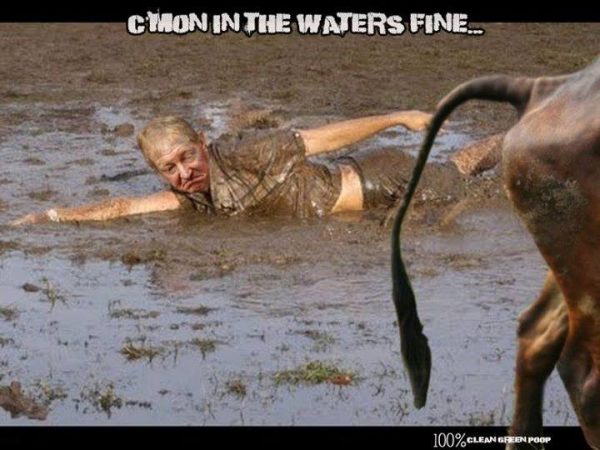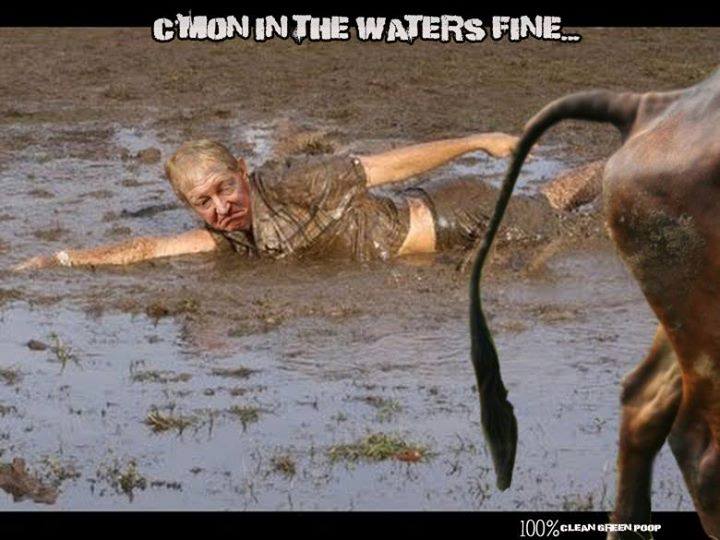
Groups withdraw support for Nick Smith’s water policy; billboard erected in Wellington CBD
The withdrawal of the second major national organisation in a week from the Minister for the Environment’s Land and Water Forum is a further sign that the Government’s new water policy is unacceptable to ordinary Kiwis.
Student-led campaign group, Choose Clean Water, say that the withdrawal of both Forest & Bird and Federated Mountain Clubs shows that groups concerned with the protection of New Zealand’s environment are giving the thumbs down to the National Government policy.
“This is a vote of no confidence in the Government’s water policy. If these two long-standing environmental groups say that they cannot support the Government’s approach, it means that the things we love as New Zealanders, our beautiful country, are at risk under this shambolic policy,” says group spokesperson, Marnie Prickett.
“A Government that was serious about solving our country’s widespread contamination of freshwater would start with strong protection in law. The National Policy Statement on Freshwater Management fails to protect the values we have as New Zealanders.
The public want safe, clean, swimmable, healthy rivers, lakes and streams and our country deserves an honest effort from their Government not smoke and mirrors.”
In an interview earlier in the week, Forest & Bird Chief Executive Kevin Hague said that after 9 years involvement on the Land and Water Forum, the Government had presented a policy to New Zealand that would make pollution of fresh water worse.
The have been followed today by Federated Mountain Clubs and we expect that more groups could leave soon.
Choose Clean Water, along with online campaign organisation ActionStation, erected a 12-metre long crowd-funded billboard in Wellington this morning to draw attention to the Government’s worsening of standards. It reads, “This Government thinks you won’t notice more poo in your water.”
The billboard will be up at the busy Manners Street site for a month. It invites the public to send messages to Prime Minister Bill English telling him that New Zealand deserves safe water from the group’s website, www.choosecleanwater.org.nz






AWESOME !!!
Sent my letter to PM English. – Thanks The Daily blog.
Dear PM Bill English,
11th March 2017.
Regarding your freshwater policy;
Please review this article from NIWA later after our submission to you below please.
https://www.niwa.co.nz/freshwater-and-estuaries/freshwater-and-estuaries-update/freshwater-update-35-july-2010/reducing-contaminant-runoff-from-roads
“Heavy metals, released by wear on tyres and brake pads, are washed off roads and can contaminate rivers, streams and harbours. NIWA has recently completed a study to measure how much copper and zinc is discharged in road runoff, and how well different storm water devices remove these contaminants from runoff.”
PM Bill English,
Regarding your freshwater policy;
Are you aware of the other elephant in the room that adds even more toxic pollution to our waterways that your Government are causing with your total reliance on only road freight and truck mania while you choose to close down rail all over the country especially in the province’s that produce all the exports???
HB and Gisborne provincial regions are just two cases of rail closures and now roads are clogged with heavy trucks!!!!!
Here is so far what your government has not considered;
Many studies are now emerging that confirm that transport road runoff of other toxic transport sources of pollution including many cancer causing chemicals are leeching into our streams from highways and into our rivers and lakes and are so far principal components of tyres besides just the copper & zinc, now components that make Tyres are cancer and nervous system toxins from 1,3, butadiene, and styrene all recorded and solidly confirmed in studies, so do you know of this please?
We have many studies from overseas that refer to the two principal Petroleum components 1,3,Buadiene and styrene that are now considered harmful to aquatic life and humans, thus it is important if we can get some local studies made so we can reference them please?
If you haven’t included these two toxic components yet can you point this out to your administration so our future water supply may be saved from total toxicity???
Tyres are made from oil as distillates producing chemicals that cause cancer.
Just look up 1,3, Butadiene – styrene as the two principal chemicals in truck tyres and see for yourselves. https://ntp.niehs.nih.gov/ntp/roc/content/profiles/butadiene.pdf
Report on Carcinogens, Fourteenth Edition
For Table of Contents, see home page: http://ntp.niehs.nih.gov/go/roc
1,3-Butadiene
CAS No. 106-99-0
Known to be a human carcinogen
First listed in the Fifth Annual Report on Carcinogens (1989)
H2CCHHCCH2
Carcinogenicity
1,3-Butadiene is known to be a human carcinogen based on sufficient evidence of carcinogenicity from studies in humans, including epidemiological and mechanistic studies. 1,3‑Butadiene was first listed in the Fifth Annual Report on Carcinogens in 1989 as reasonably anticipated to be a human carcinogen based on sufficient evidence of carcinogenicity from studies in experimental animals. The listing was revised to known to be a human carcinogen in the Ninth Report on Carcinogens in 2000.
Also seen now both Styrene & 1,3,Butadiene are carcinogenic causing substances that are in tyre dust.
This from http://www.abc.net.au/science/articles/2012/07/31/3554997.htm
Each time a tyre rotates, it loses a layer of rubber about a billionth of a metre thick. If you do some numbers, this works out to about four million million million carbon atoms lost with each rotation.
A busy road with 25,000 vehicles travelling on it each day will generate around nine kilograms of tyre dust per kilometre. In the USA, about 600,000 tonnes of tyre dust comes off vehicles every year.
In the Australian outback, traces of lead from car exhausts have been found up to 50 kilometres away from the nearest road. So some of the tyre dust can travel that far — but of course, most of it will settle around the road and enter the waterways nearby.
We are very interested to protect our waterways and health of our people and our future and we advocate more use of rail.
You was quoted in the press in 2009 as saying;
“we cannot afford a rail system and a road network also”
Now after years of neglect of rail we need rail freight to lower the truck freight pollution that now threatens our water supply and public health of our nation.
Thanks for your attention,
We await your response.
But the money’s so good!
Comments are closed.